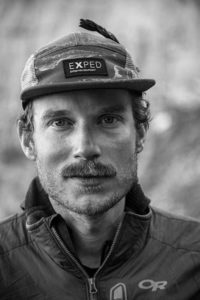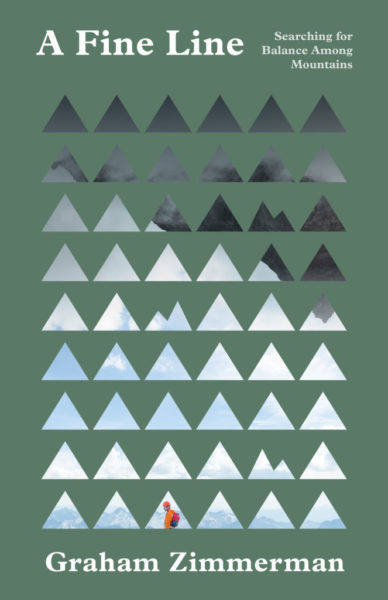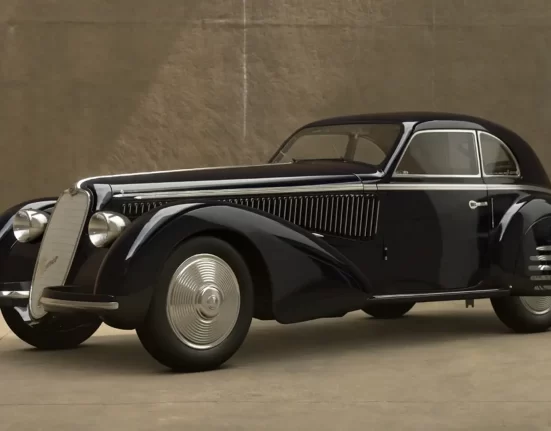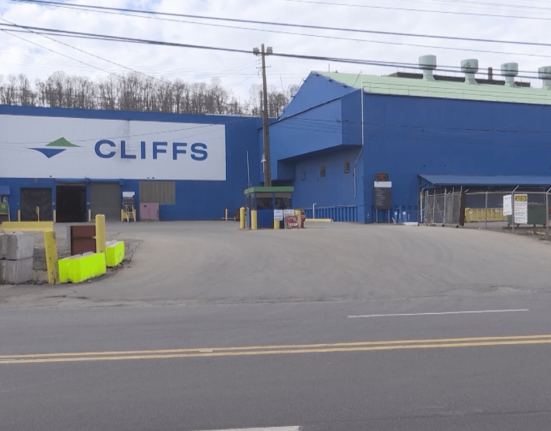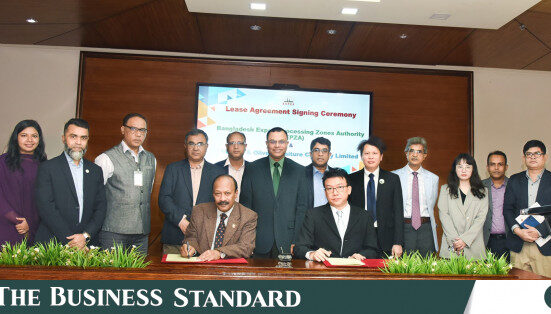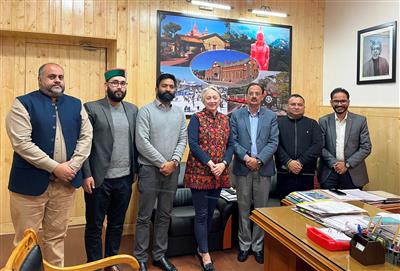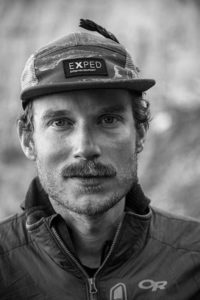

6:30 – 8 p.m., Tuesday, Nov. 7
Edmonds Waterfront Center, 220 Railroad Ave., Edmonds
In his debut book, A Fine Line: Searching for Balance Among Mountains, renowned alpinist Graham Zimmerman grapples with how to reconcile the love of outdoor adventure with the cost of such endeavors, both human and environmental. Zimmerman will speak at the Edmonds Waterfront Center as part of an event with the Edmonds Bookshop. He lives in Bend, Oregon with his wife Shannon and their dog Pebble. His very proud parents live right here in Edmonds. (Learn more on his website.)
For more information about the event, visit the new Edmonds Bookshop website.
Reserve your seat online here or pay at the door. Walk-ins are welcome.
Art Beat columnist Elizabeth Murray chatted with Zimmerman ahead of his event at the Waterfront Center.
EM: Tell me about A Fine Line: Searching for Balance among Mountains. What sparked the desire to tell your story?
GZ: It’s interesting to be working on a memoir mid-career. It wasn’t the plan at the beginning; I was working on another book and was working with a publisher. They came back and said, “How would you feel about writing a memoir?” I had this really great conversation about this last night with my wife and a couple of our good friends about how writing this story well, while the memories are more fresh has been cool. One of my favorite parts of writing this book was digging into who I was and how I was thinking as a young climber. It’s pretty different from who I am now.
EM: As a writer and reader, I especially appreciated your vivid writing style. It’s very poetic. Can you tell readers a bit about the process of writing the book? You’ve written articles before; how was writing your book different?
GZ: I spent a lot of time on the process. I definitely didn’t write this book like, “Okay chapter one, here we go…” I did some aggressive outlining. My goal was less to tell people about me and more to inspire them to climb or follow their passion. To think about how that passion can be leveraged to drive change in the world around them, and also how to balance those passions with marriage, career, and advocacy. I had that top-line goal in mind, wrote the outline for the chapters, and continued to make that outline more and more specific to the point where I was filling in the blanks when I wrote the rough draft. The main thing I had to focus on was the connective tissue between all those portions of the book.
To speak to the writing style. First off, I need to be really clear that the Mountaineers Books team was super helpful. I could not have produced this book on my own.
The last thing I’ll share that was really helpful for me was to go find another book that I wanted to sound like. As part of this project, I probably read 40 memoirs. Of course, the book I landed on that I wanted to sound like won the Pulitzer, so it was like shooting for the moon. William Finnigan’s Barbarian Days. I just read that over and over and over again while writing my own memoir.
EM: You have been awarded the Piolet d’Or. For those who are not familiar with the climbing world, what is that?
GZ: The Piolet d’Or is the highest honor in Alpine climbing. It means “the golden ice axe.” It was a special deal to be awarded that, particularly for the climb that it was awarded for, which was the climb on Link Sar with Mark Richey, Steve Swenson and Chris Wright. That was a special climb for a lot of reasons. A, the objective was incredible. It was a hard, complex mountain in a hard-to-permit area, but more importantly, the time spent on the mountain with those guys was incredible. It was some of the best partnerships that I’ve experienced.
EM: As a non-climber, I’ve always thought of mountain climbing as a solitary sport, man vs. mountain. In your book, I was surprised to learn it’s very much a team endeavor. You’re putting your life in the hands of your climbing partner. You described an experience where you were flagging and your partner, Mark Kendrick, noticed you hadn’t eaten and made you eat a whole salami before letting you give up or continue. In your book, you describe how you have been shaped by the different partners you’ve worked with. In what ways do you think or hope you have influenced them?
GZ: I had a really great conversation earlier today about teamwork. It’s always easy to look at a problem in our lives and get pretty myopic in terms of thinking about how “I can solve that” and how “I can push that needle forward.” Something that climbing has taught me is the power of partnership and the power of building strong teams that have strong strategies behind them in order to take on things that are larger than they might be able to take on by themselves. That’s something I see in my climbing career, and as I’ve gone through my climbing career I’ve focused on building teams that are bigger than the constituent of their parts. Our combined efforts create something where one plus one equals far more than two.
It’s funny to talk about that because climbing is this annoyingly amazing metaphor for how we take on big things. When we talk about big challenges in advocacy, we talk about how we’re going to climb this mountain. So I’m pretty fortunate to have lived that metaphor a lot. When I think about what I bring to climbing partnerships it’s about really trying to build camaraderie and trying to empower others to lean into their strengths.
EM: There is a quote that resonated with me, “They were times when we had defined for ourselves the vague difference between danger and fear — the former to be avoided, the latter to be explored and, if possible, set aside.” What have you discovered as you’ve explored fear? As a husband, how has the space between danger and fear changed? Has your perspective as a climber shifted now that you have this person who counts on you to come home?
GZ: I’ll share that Shannon [Zimmerman’s wife] just stuck out her tongue at me. I feel very fortunate that I have had some great mentors in my life who have encouraged me to look at a longer perspective of my climbing career. Understanding that as I think about climbing I should not get stuck on one trip, one objective, but should instead look at this longer goal of climbing for 100 years or living to be 100 years old. When I was a younger climber, my willingness to take on risks was pretty high.
Shannon has been a really big part of that journey. Shannon has certainly encouraged me to climb in a meaningful way. At one point she asked me that I wouldn’t free solo anymore. This was this really powerful inflection point, because free soloing wasn’t a core part of my role as an athlete or a core of what I did, but it just happened because everybody was doing it. To have this person say “Hey listen I’m psyched to invest in you, but I’d love it if you could cut out this more dangerous part of climbing that you’re participating in,” was a really powerful moment. It was the easiest thing to say “yes” to. Shannon has done a great job of being super empowering in my life to do better in the mountains and also survive in the mountains. That’s the reason the book is dedicated to her.
EM: Since this is the arts column, I loved this section where you said, “I started to see the mountains not only as a problem to be solved but also as a canvas on which I could lay down a brushstroke. I was being asked to present and write on my climbing, and within this I saw potential to make my stories stronger, to make my messaging more potent, while keeping the subjectivity reined in so they were still true.” That quote lays out the beginning of an awareness of your voice and platform. Let’s discuss your climate advocacy with Protect Our Winters (POW). How did you get started? What do you do for them?
GZ: People often ask “What was your inflection point that got you into climate advocacy?” They’re always expecting like “Oh I was standing on this mountain and looking out and realized oh my gosh, climate change is real.”
I don’t have a story like that. I studied glacial hydrology in university and am very aware of climate change. What that means is I was going to the mountains for many years and seeing the clear signs of climate change and wasn’t empowered to do anything about it. The reason I didn’t feel empowered was the perceived hypocrisy around my personal carbon footprint that made me feel like I could not advocate about climate or do anything about climate.
In 2016, when I was at the 5Point Film Festival, a good friend of mine named Brody Leven, who does a lot of work with POW, was there. He was telling me, “Hey listen, you should get involved in this. One of the folks from the leadership team from POW is here.” We went and sat down with her. She was like “Oh man, yeah you’re the perfect person to take on this conversation. We’d love to bring you into the fold and teach you how and why.”
The short of it is that we’ve been sold the idea that we solve climate through personal change. We solve climate by either driving less, flying less, buying an electric vehicle (EV), or putting solar panels in our homes. That’s this concept that’s been sold to us by the fossil fuel industry. It’s the fossil fuel lobby that invented the idea of the carbon footprint.
When we look into how we actually solve climate, we have to take on our systemic emissions and big industry emissions. We as individuals can influence those systems through government.
When we talk about personal change when it comes to climate, and you look at the solutions that are presented, they cost a lot of money. That means in terms of when we look at personal change as a solution, it has this massive social equity problem. Considering that your average American has less than $800 in their savings account, that means that most Americans get left behind. If we look globally that means most of the globe gets left behind.
Through systemic change, we can bring everybody along on that clean energy journey. That’s the core component that keeps me moving forward on that work. At this point, I’m doing a lot of policy work and a lot of political work. It’s most of what I do outside of climbing.
EM: What do you hope the readers of your book take away from it?
GZ: My hope is that readers of this book will take away the idea that balance can be a strength. Oftentimes in our society, it is seen that if you want to do well at something you have to give up everything else. My journey has exemplified another pathway on that, in which by authentically building things together, building strong teams, and bringing everybody along on that journey, you can do far more. A crucial component of that is that you can go do really big hard things and also be a good partner.
Contained within the story is my discovery of levers that I have in my life to drive change in the world around me. I feel very strongly that everybody has those levers. We just need to identify them and learn to operate them and learn how to operate them in a sustainable way. That’s something I hope folks take away.
Also to have fun on a climbing journey.
EM: You grew up in Edmonds. What are some of your must-do’s here on your home turf?
GZ: First and foremost is hanging out with Mom and Dad, because I don’t get much time at home anymore. When I am in Edmonds, it is really lovely to have some downtime with them at their house. I do always go to the Edmonds Bookstore. I love independent bookstores and going down there is a treat. I’m somebody who grew up sandwiched between the mountains and the water. I obviously gravitated toward the mountains, but being close to the ocean is something I love, so I love hanging out by the waterfront.
EM: What can those who attend your author talk at the Waterfront Center expect?
GZ: We’re going to show a short film; it’s about five minutes long. Then it’s going to be a conversation between myself and David Brewster, which I’m excited about. I’ve known him as somebody who’s been doing cool cultural stuff for a long time. Somebody who’s a thoughtful member of our community.
I will also be selling books and signing books. I love Q and A. I love it when folks have questions; I don’t want them to feel limited in what they ask. I’m delighted to come engage with the Edmonds community. It’s the place where this whole thing started.
— By Elizabeth Murray

